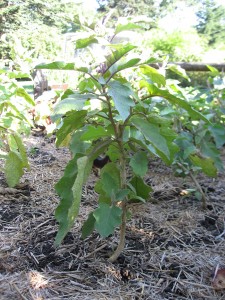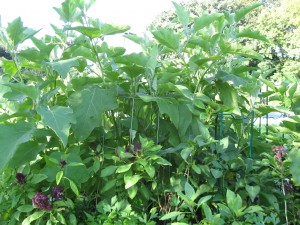Tip of the Week: When Cutting Corners Goes Awry
Posted in Gardening Tips on November 16 2009, by Sonia Uyterhoeven
 |
Sonia Uyterhoeven is Gardener for Public Education. |
In the gardening world we all talk about “cultural care” and nod our heads knowingly: Growing requirements for vegetables include full sun, proper spacing, good drainage, and some kind of soil amendment, preferably organic material. We know the drill.
Being human, however, we often cut corners and hope for the best. Plants tend to be fairly accommodating—they grow in spite of everything we do to them—and often we walk away feeling like a success.
This year, however, the weather was so inhospitable that any corners cut turned into messy gaps in the garden.
 It was a miserable year for the “fruiting” vegetables such as peppers, eggplants, and tomatoes—at least in my garden. The warm-season crops sulked or came to a screeching standstill early in the season when June decided it was April and summer went on an extended leave of absence.
It was a miserable year for the “fruiting” vegetables such as peppers, eggplants, and tomatoes—at least in my garden. The warm-season crops sulked or came to a screeching standstill early in the season when June decided it was April and summer went on an extended leave of absence.
In one part of the garden we planted young transplants of peppers and eggplants in early June as is our common practice. The cool temperatures stunted their growth and these vegetables never entirely recovered (see photo at right). Why? They were planted in an area that is not blessed with full sun. With all the rain, the soil stayed cool and excessively moist for half the season.
While these conditions work for leafy cool-season vegetables, they challenged the members of the Solanaceae family. My peppers didn’t have a chance. In another area of the garden, a similar array of vegetables was planted at the same time in a location with full sun.
 There were no comparisons between the two gardens. The latter started slowly and then took off (see photo at left). By September, I was harvesting handfuls of white and purple eggplants (‘Ghostbuster’ and ‘Classic’) and some stylish purple bell peppers (‘Lilac hybrid’) that were wonderfully mild.
There were no comparisons between the two gardens. The latter started slowly and then took off (see photo at left). By September, I was harvesting handfuls of white and purple eggplants (‘Ghostbuster’ and ‘Classic’) and some stylish purple bell peppers (‘Lilac hybrid’) that were wonderfully mild.
It was a wonderful illustration of how proper site conditions can make or break a situation. This year it was imperative to plant warm-season vegetables in the full sun they require, otherwise the air and soil (their growing environment) remained too cool and wet and they did not receive the warmth that they needed.
All I can say is that when life hands you lemons, make lemonade. In the vegetable world it was more a case of making sauerkraut and a hearty salad (minus the tomatoes and cucumbers) as cabbages were colossal and lettuces were lush.

